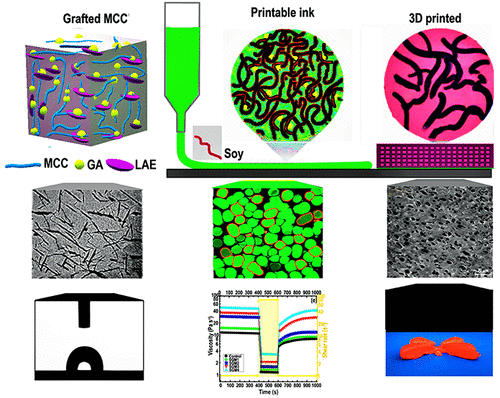当前位置:
X-MOL 学术
›
J. Agric. Food Chem.
›
论文详情
Our official English website, www.x-mol.net, welcomes your
feedback! (Note: you will need to create a separate account there.)
A Promising Therapeutic Soy-Based Pickering Emulsion Gel Stabilized by a Multifunctional Microcrystalline Cellulose: Application in 3D Food Printing
Journal of Agricultural and Food Chemistry ( IF 5.7 ) Pub Date : 2022-02-10 , DOI: 10.1021/acs.jafc.1c05644 Mahdiyar Shahbazi 1 , Henry Jäger 1 , Rammile Ettelaie 2
Journal of Agricultural and Food Chemistry ( IF 5.7 ) Pub Date : 2022-02-10 , DOI: 10.1021/acs.jafc.1c05644 Mahdiyar Shahbazi 1 , Henry Jäger 1 , Rammile Ettelaie 2
Affiliation

|
The feasible application of additive manufacturing in the food and pharmaceutical industries strongly depends on the development of highly stable inks with bioactive properties. Surface-modified microcrystalline cellulose (MCC) shows the potential of being a useful particulate (i.e., Pickering)-type emulsifier to stabilize emulsions. To attain desired therapeutic properties, MCC can also be tuned with cationic antimicrobial compounds to fabricate an antimicrobial printable ink. However, due to the formation of complex coacervates between the two, the Pickering emulsion is very susceptible to phase separation with an insufficient therapeutic effect. To address this drawback, we reported a green method to produce antioxidant and antimicrobial three-dimensional (3D)-printed objects, illustrated here using a printable ink based on a soy-based particulate-type emulsion gel stabilized by a surface-active MCC conjugate (micro-biosurfactant). A sustainable method for the modification of MCC is investigated by grafting gallic acid onto the MCC backbone, followed by in situ reacting via lauric arginate through Schiff-base formation and/or Michael-type addition. Our results show that the grafted micro-biosurfactant was more efficient in providing the necessary physical stability of soy-based emulsion gel. The grafted micro-biosurfactant produced a multifunctional ink with viscoelastic behavior, thixotropic property, and outstanding bioactivities. Following the 3D printing process, highly porous 3D structures with a more precise geometry were fabricated after addition of the micro-biosurfactant. Dynamic sensory evaluation showed that the micro-biosurfactant has a remarkable ability to improve the temporal perceptions of fibrousness and juiciness in printed meat analogue. The results of this study showed the possibility of the development of a therapeutic 3D-printed meat analogue with desired sensory properties, conceiving it as a promising meat analogue product.
中文翻译:

由多功能微晶纤维素稳定的有前景的治疗性大豆基 Pickering 乳液凝胶:在 3D 食品打印中的应用
增材制造在食品和制药行业的可行应用很大程度上取决于具有生物活性的高度稳定油墨的开发。表面改性的微晶纤维素(MCC)显示出作为有用的颗粒(即皮克林)型乳化剂来稳定乳液的潜力。为了获得所需的治疗特性,MCC 还可以与阳离子抗菌化合物一起调节,以制造抗菌可印刷油墨。然而,由于两者之间形成复杂的凝聚层,Pickering乳液非常容易发生相分离,治疗效果不足。为了解决这个缺点,我们报道了一种生产抗氧化和抗菌三维(3D)打印物体的绿色方法,这里展示的是使用基于大豆基颗粒型乳液凝胶的可打印墨水,该凝胶由表面活性MCC缀合物稳定(微生物表面活性剂)。研究了一种可持续的 MCC 改性方法,将没食子酸接枝到 MCC 主链上,然后通过月桂酸精氨酸通过希夫碱形成和/或迈克尔型加成进行原位反应。我们的结果表明,接枝的微生物表面活性剂可以更有效地为大豆基乳液凝胶提供必要的物理稳定性。接枝的微生物表面活性剂产生了具有粘弹性、触变性和出色的生物活性的多功能墨水。在 3D 打印过程中,添加微生物表面活性剂后,可以制造出具有更精确几何形状的高度多孔 3D 结构。 动态感官评价表明,微生物表面活性剂具有显着改善印刷仿肉纤维度和多汁性的时间感知的能力。这项研究的结果表明了开发具有所需感官特性的治疗性 3D 打印人造肉的可能性,将其视为一种有前途的人造肉产品。
更新日期:2022-02-10
中文翻译:

由多功能微晶纤维素稳定的有前景的治疗性大豆基 Pickering 乳液凝胶:在 3D 食品打印中的应用
增材制造在食品和制药行业的可行应用很大程度上取决于具有生物活性的高度稳定油墨的开发。表面改性的微晶纤维素(MCC)显示出作为有用的颗粒(即皮克林)型乳化剂来稳定乳液的潜力。为了获得所需的治疗特性,MCC 还可以与阳离子抗菌化合物一起调节,以制造抗菌可印刷油墨。然而,由于两者之间形成复杂的凝聚层,Pickering乳液非常容易发生相分离,治疗效果不足。为了解决这个缺点,我们报道了一种生产抗氧化和抗菌三维(3D)打印物体的绿色方法,这里展示的是使用基于大豆基颗粒型乳液凝胶的可打印墨水,该凝胶由表面活性MCC缀合物稳定(微生物表面活性剂)。研究了一种可持续的 MCC 改性方法,将没食子酸接枝到 MCC 主链上,然后通过月桂酸精氨酸通过希夫碱形成和/或迈克尔型加成进行原位反应。我们的结果表明,接枝的微生物表面活性剂可以更有效地为大豆基乳液凝胶提供必要的物理稳定性。接枝的微生物表面活性剂产生了具有粘弹性、触变性和出色的生物活性的多功能墨水。在 3D 打印过程中,添加微生物表面活性剂后,可以制造出具有更精确几何形状的高度多孔 3D 结构。 动态感官评价表明,微生物表面活性剂具有显着改善印刷仿肉纤维度和多汁性的时间感知的能力。这项研究的结果表明了开发具有所需感官特性的治疗性 3D 打印人造肉的可能性,将其视为一种有前途的人造肉产品。


















































 京公网安备 11010802027423号
京公网安备 11010802027423号